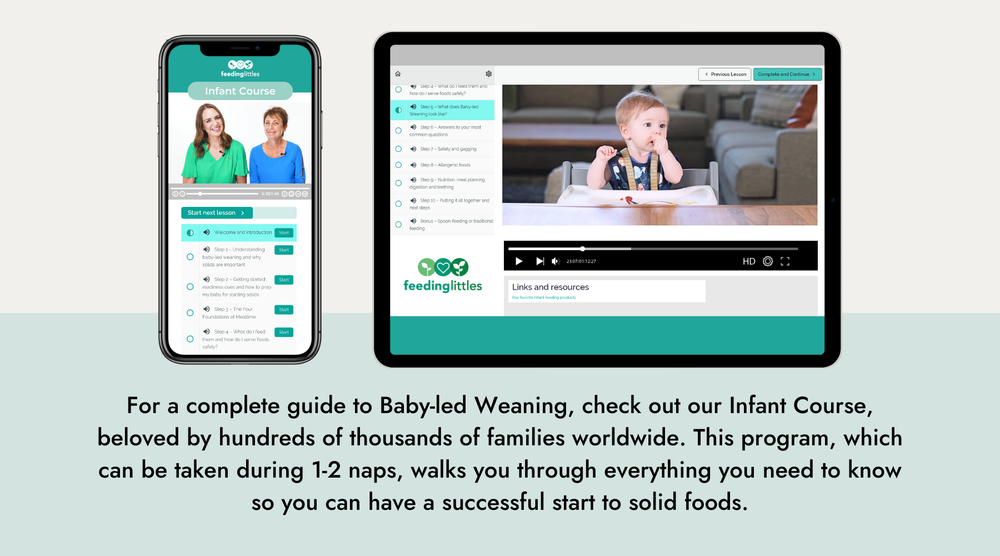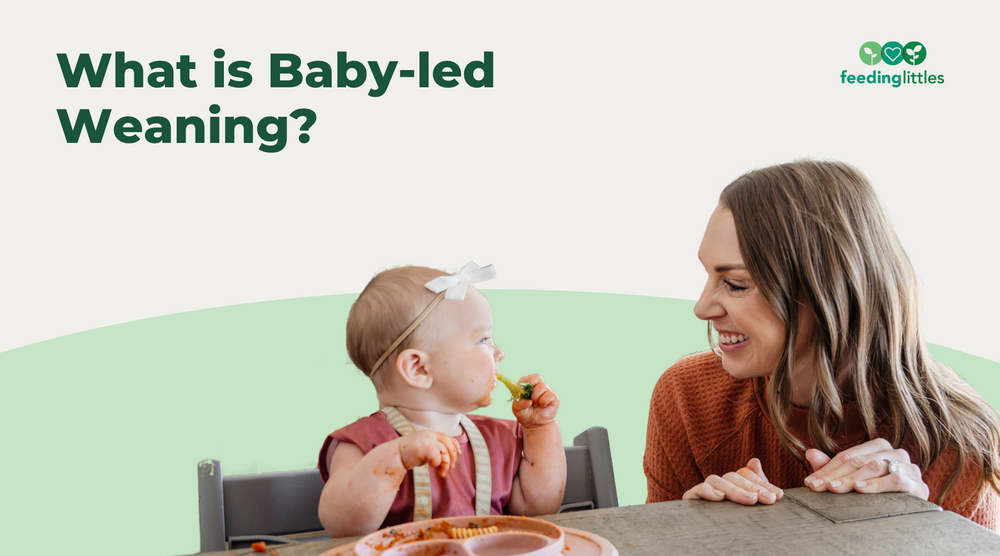
Baby-led Weaning has become very popular in the United States over the last decade. Many people think Baby-led Weaning (BLW) means letting baby self-wean from the breast or bottle. However, the term "weaning" outside of the United States means starting solid foods, so Baby-led Weaning means baby-led starting solid foods.
BLW involves offering finger foods in a shape a new eater (6 months or so) can pick up - generally a stick, strip or wedge. Foods should be soft and easily chewed with your baby's back gums.
At Feeding Littles, we have loved teaching Baby-led Weaning since 2013. It has been wonderful walking families through this fun, messy process. However, Baby-led Weaning can be a point of stress for some parents, especially if they feel like there are a lot of "rules" or that BLW must be all-or-nothing.
We wanted to explain our approach to BLW in this article. Here are the main points that we discuss below:
- Baby-led Weaning (BLW) is an approach to starting solid foods by which babies feed themselves from the beginning, starting around 6 months of age.
- Parents don’t have to puree their baby’s food or buy commercial baby food if they don’t want to; rather, they can offer soft strips or sticks of food for their baby to chew.
- BLW promotes independence, eating what the family eats, and might prevent some level of picky eating. Many families enjoy it because they don’t have to make separate meals for their babies, and it’s fun to watch babies explore new flavors and textures.
- Baby-led Weaning does not increase a baby’s risk of choking as long as choking hazard foods are modified or avoided.
- Babies do not need teeth to eat soft food; rather, they chew with their soft back gums.
- With Baby-led Weaning, spoon-feeding is not necessary. Baby puts food in their own mouth. However, some parents still choose to spoon-feed their baby, and that’s OK too.
- Babies do not need teeth to eat soft finger foods.
- Babies are ready for BLW when they can sit with minimal assistance, can bring their hands and safe toys to their mouth and show an interest in food. We recommend starting around 6 months of age and when they demonstrate these developmental skills.
- Start with soft foods like cooked broccoli, avocado strips, banana strips, poached chicken, strips of salmon fillet, buttered toast or soft pears.
- Strips of food are important because babies can’t pick up small pieces of food at 6 months of age.
- Start with 1 meal a day at 6 months and work up to 3 meals a day by 9 months.
- Gagging is normal when you start - listen for sound and watch your baby closely. We recommend that everyone feeding babies any type of food have been trained in first aid and CPR, as babies can choke on any texture or object they put in their mouths.
- It’s important to offer allergenic foods like peanut butter, shrimp and eggs.
- Our Infant Course walks you through this whole process with 14 printables, including Baby’s First Grocery List, a Meal Plan and “It Takes a Village,” a handout for grandparents and other care providers.
Baby-led Weaning is an approach to offering solid foods where babies feed themselves. It was originally defined in the book Baby-led Weaning by Gill Rapley in 2008 and has gained popularity all over the world since then. Megan has been teaching Baby-led Weaning classes in-person since 2013, and we created the Feeding Littles online Infant Course in 2017. It has been amazing to watch hundreds of thousands of babies go through the process of discovering new flavors and textures and having fun at the dinner table, and we are grateful to have learned about Baby-led Weaning all those years ago.
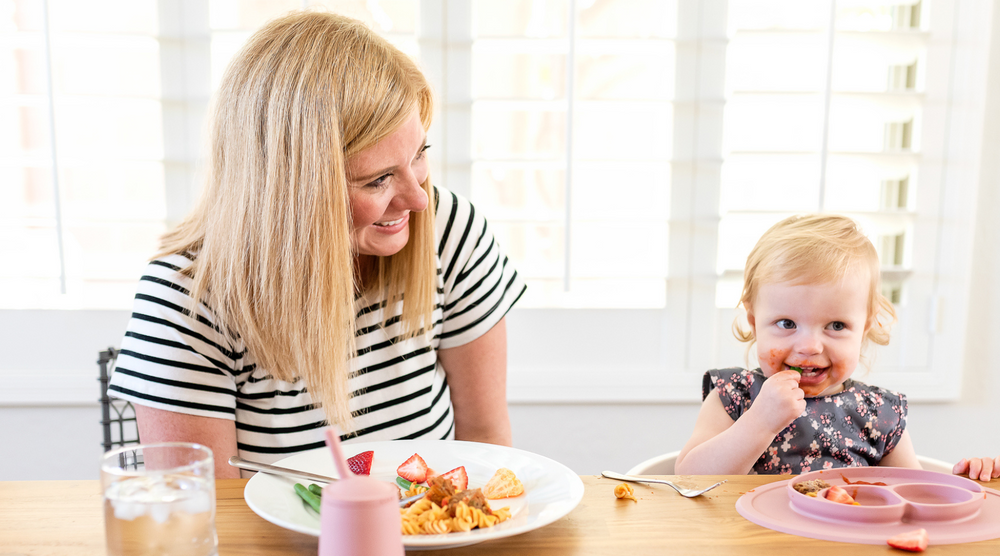
Baby-led Weaning (BLW), also known as infant self-feeding, allows babies to feed themselves real food when they begin solids around 6 months of age. Instead of offering only pureed food on a spoon, parents give their soft, stick-shaped foods that they can pick up and bring to their own mouth. Babies learn to eat all sorts of safe textures - from chicken to roasted broccoli to buttered toast - by feeding it to themselves.
Fans of Baby-led Weaning love that it promotes independence at mealtime, allows babies to eat what the family eats and makes family meals more practical because parents make the same meal for everyone. It might have a positive impact on picky eating as babies get older, helps babies tune into their satiety cues and might be more beneficial for speech development than parent-led feeding. It can also help develop babies’ fine motor and oral-motor (chewing, swallowing) skills and is easier for many families because they don’t have to prepare special foods for their infants. However, more research is needed to fully understand the benefits of Baby-led Weaning.
One reason we love BLW so much? It establishes a positive feeding dynamic between babies and their caregivers, one that allows babies to be in charge of what and how much food goes in their mouth. We recommend the model “You provide, child decides” when feeding kids of all ages, meaning that you provide the food and your child decides how much of it to eat. With Baby-led Weaning, you’re starting “You provide, child decides” right from the start. (You’ve actually been doing this all along with breastfeeding or bottle feeding - you’re simply continuing it into your solids journey.)

However, we don’t think that BLW is the “end-all, be-all” of feeding kids. If you don’t do it, your child isn’t “doomed” to a life of picky eating. There are so many factors that contribute to how a child eats long-term. We simply love BLW because it promotes self-feeding, self-regulation and family meals, all of which can contribute to more success with eating long-term.
You can still watch your baby’s cues and promote independence at the table if you start with spoon-feeding. What matters most is doing what works for your family and your baby.
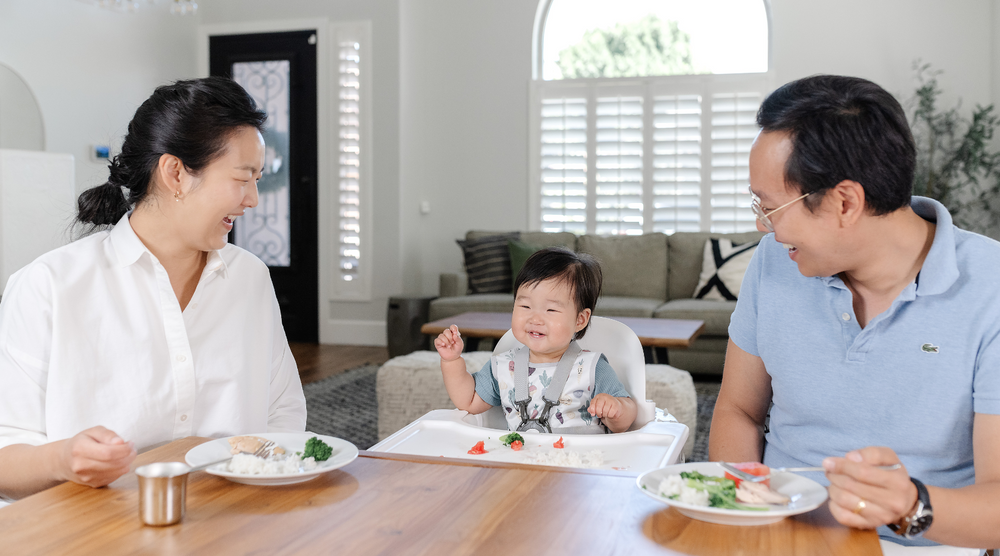
Can my baby eat whole foods? Is that safe?
Yes! The data we have available suggests that BLW is just as safe, if not even more safe, than traditional spoon-feeding. Why? Some practitioners theorize that BLW teaches babies to chew before swallowing, whereas in puree/spoon-feeding, babies don’t necessarily chew first.
Of course, safety is of the utmost importance when offering food to babies, and it’s important to modify or avoid choking hazards for babies and toddlers until age 4. These choking hazards include foods like:
- Grapes, cherries and cherry tomatoes (quarter lengthwise)
- Whole nuts (serve as thinly-spread nut butters)
- Hot dogs and sausage (cut into small pieces)
- Chips or any hard foods (avoid)
What about spoon-feeding baby foods?
Spoon-feeding became popular in the early 1900s when formula-feeding became very popular for infants. At the time, many parents made formula from simple ingredients at home, and they didn’t have vitamin drops or any technology to fortify formula with iron. Many babies quickly became iron deficient. Pediatricians began to recommend pureed foods that babies could essentially drink so they received enough iron. If you look at your parents’ or grandparents’ baby books, you might notice that they started solid foods very early - in some cases, at a few days or weeks of age!
Because babies were eating solid foods at such a young age, pureed or liquified foods were essential. These babies could not sit up independently and likely did not have head or neck control, and they needed something that could be safely spooned into their mouths.
Commercial baby food became very popular as a convenient, safe option for families who needed to use purees. They soon were considered essential for babies, and people assumed that babies could not eat foods unless they were completely mashed up or blended.
Interestingly, infant feeding literature in the 20th century refers to pureed baby foods as given “customarily” or “traditionally,” but there was no evidence to prove that babies had to learn to take purees from a spoon to be able to eat successfully long-term.
We now know that it is advised to wait until approximately 6 months to start solid foods, and at this age most babies have head and neck control and are starting to learn how to sit independently. Thus, parents can skip the spoon-feeding baby food stage if they choose and allow their babies to self-feed right from the start if they want to.
Does my baby need teeth to eat foods like an avocado wedge or strip of meat?
Nope! Many babies start solid foods without a single tooth. Even if they have a front tooth or two, they don’t have chewing teeth - molars! Your baby won’t have a full set of teeth until 2-3 years of age, and we can’t wait until then to offer them real food. They actually chew quite well with their back gums using their strong jaw.
How do I know if my baby is ready for Baby-led Weaning?
We generally recommend starting any solid food (strips, purees, lumpy foods) besides breast milk or formula around 6 months of age, when your baby can:
- sit with minimal assistance on the floor and has good head and neck control.
- bring their hands and safe toys to their mouth.
- show an interest in food.
For a free guide of easy things you can do at home to help your baby reach these milestones and prep for solids, click here.
What do I need to start?
The nice thing about Baby-led Weaning is that you don’t need anything to do it, just a place for your baby to sit and food to eat. However, knowing exactly how to do it and having quality feeding gear on hand can help make it a lot easier. Our favorites include:
- Feeding Littles Infant Course - learn everything you need to get started with Baby-led Weaning, transition off of spoon-feeding or troubleshoot if things aren’t going well. Our course includes 14 beautiful printables like “It Takes a Village,” a letter to grandparents and other caregivers.
- NumNum GOOtensils - our favorite starter utensil that helps baby bring food to their mouth that’s hard to pick up with their hands.
- BapronBaby Bib - covers your baby’s clothing without being hot, bulky and uncomfortable. Baprons tie behind the torso instead of the neck, which most babies prefer. Use code FEEDINGLITTLES for a discount at bapronbaby.com.
- EZPZ Tiny Cup - perfect for learning how to drink from an open cup.
- Honeybear Straw Cup - helps your baby learn how to drink from a straw cup.
- A high chair that promotes good positioning.
What foods do I start with?
The best part about BLW is there is no one “right” food to begin with - for the most part, as long as it’s soft and in a shape your baby can pick up like a strip or stick, it’s a “go!” Many families love avocado as a first food, but roasted broccoli, peanut butter on banana, oatmeal served on a loaded spoon, full-fat yogurt, roasted butternut squash, sauteed zucchini, hummus, pear and steamed carrot are all amazing options.
Button/photo: Our Infant Course helps you understand how to safely prepare any food you want to offer your baby!
Why strips of food?
When babies start eating food around 6 months of age, most of them do not have a pincer grasp, or the ability to pick up small pieces of food between their thumb and forefinger. This skill develops closer to 10-12 months. Thus, it’s important to give them foods they can hold and bring to their mouth successfully, and that’s strips or wedges of food that are about the length of an adult picky finger.
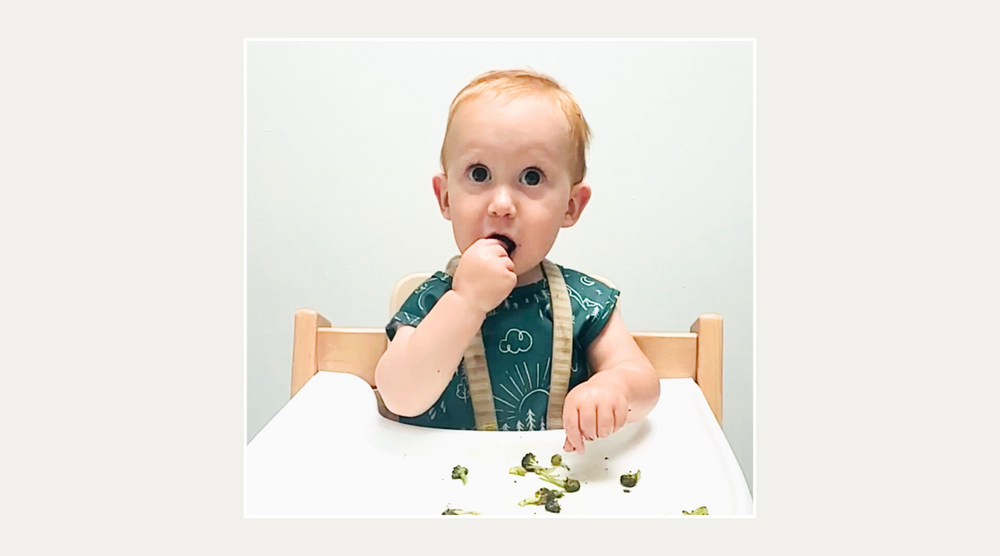
How many meals should I offer per day?
We recommend starting with at least 1 meal per day at 6 months and working up to 3 meals a day by 9 months of age. This allows your baby to get plenty of practice with self-feeding before they eventually wean from the breast or bottle.
What do I do if my baby gags?
Gagging is a normal part of learning how to eat and is considered an oral protective mechanism. Your baby will likely gag at the beginning of BLW, and it’s OK as long as you can hear sound. Sound = air. You should see the food come further forward in your baby’s mouth for them to spit out or keep attempting to chew.
Gagging and choking are not the same thing. Choking is when your baby’s airway is completely blocked and requires immediate first aid measures (back blows). Choking is not an expected part of the feeding process, but it can technically happen with any food or non-food item your baby puts in their mouth, so it’s important to know what to do in the event that it happens. We recommend taking an Infant CPR class locally or online.
For a complete guide to safety and gagging, check out our Infant Course.
Do I need to offer allergenic foods?
Yes, as long as your doctor hasn’t told you otherwise. Early, frequent allergen exposure is important for babies and can help lower their risk of a food allergy. The top 9 allergens in the U.S. are peanuts, tree nuts, finned fish, shellfish, soy, dairy, wheat, eggs and sesame. Our Infant Course walks you through how to offer these foods safely to your baby, how to know if they’re having an allergic reaction and how to lower their allergy risk.
What about breast milk or formula?
Your baby will likely drink the same amount of breast milk or formula as they did prior to starting solid foods, and this is because solids are meant to complement - not replace - milk feeds. The goal is for your baby’s intake of solid foods to gradually increase, and this might mean they start drinking less milk eventually, but it oftentimes doesn’t happen until 10-12+ months. Our Infant Course includes a Milk and Weaning eBook that walks you through the breast or bottle weaning process, helps you select a milk for your toddler (or know what to serve if your child doesn’t drink milk), offers tips on breastfeeding toddlers and much, much more.
